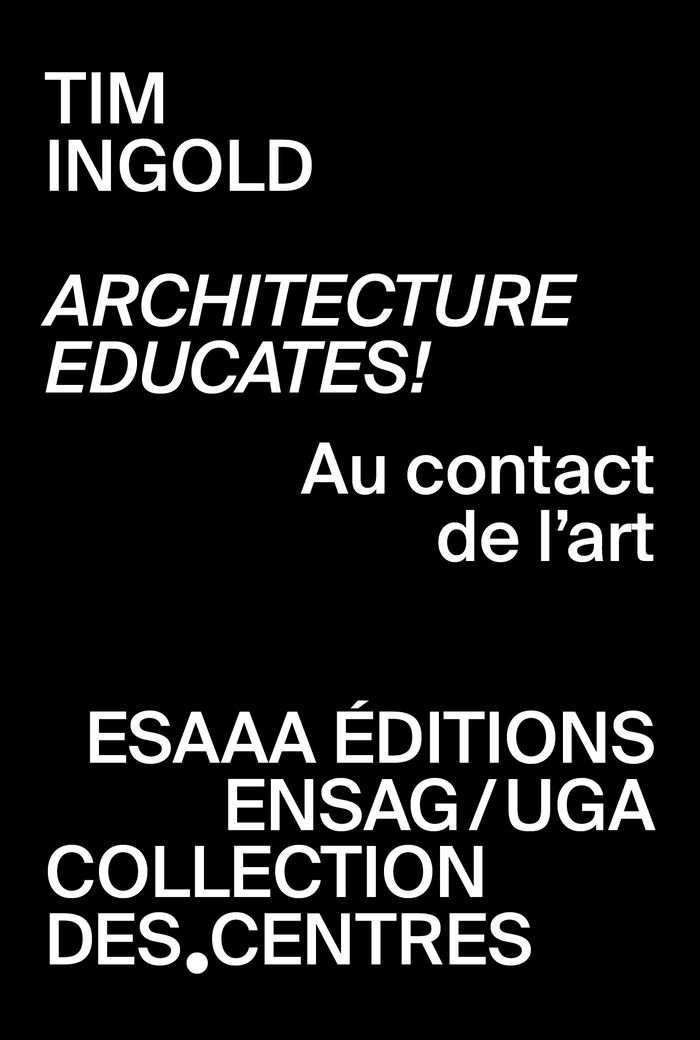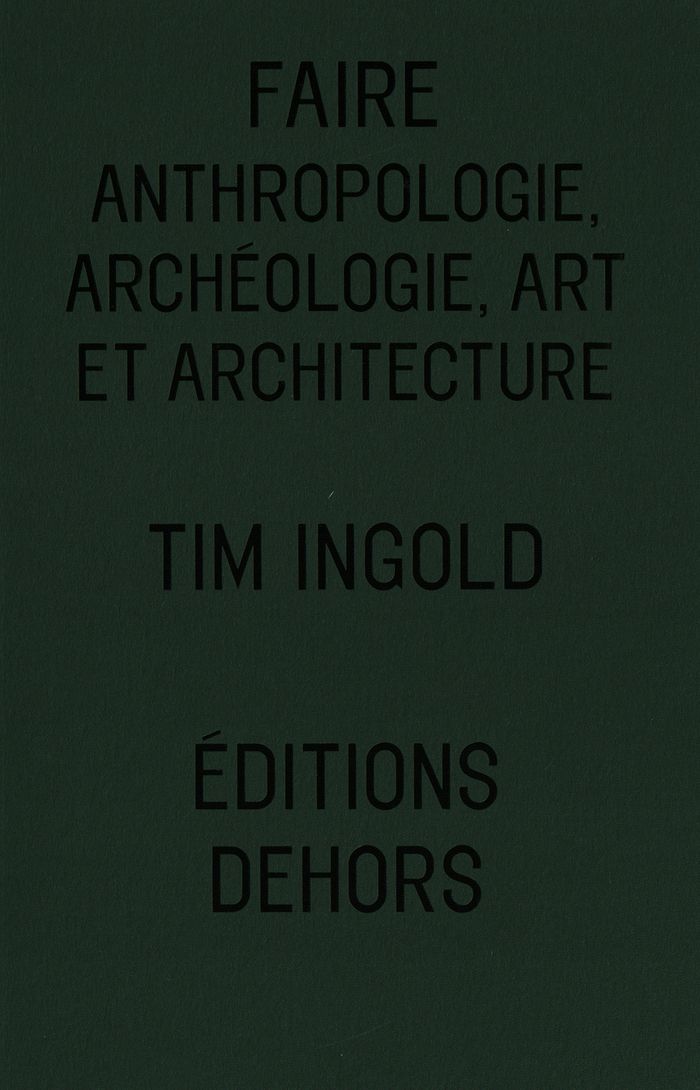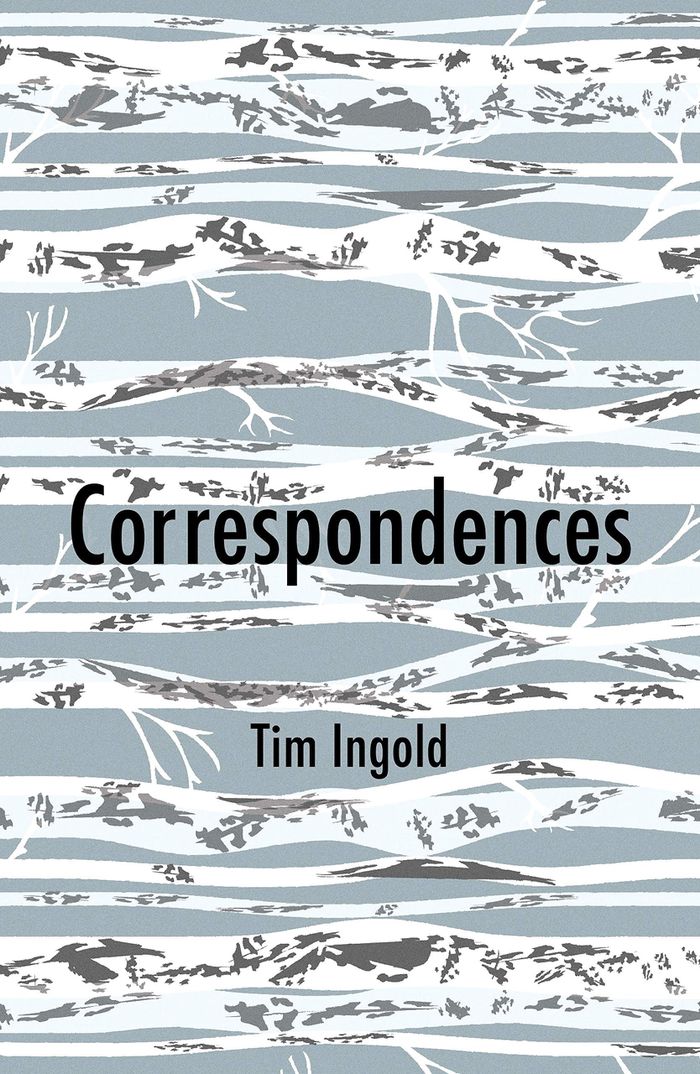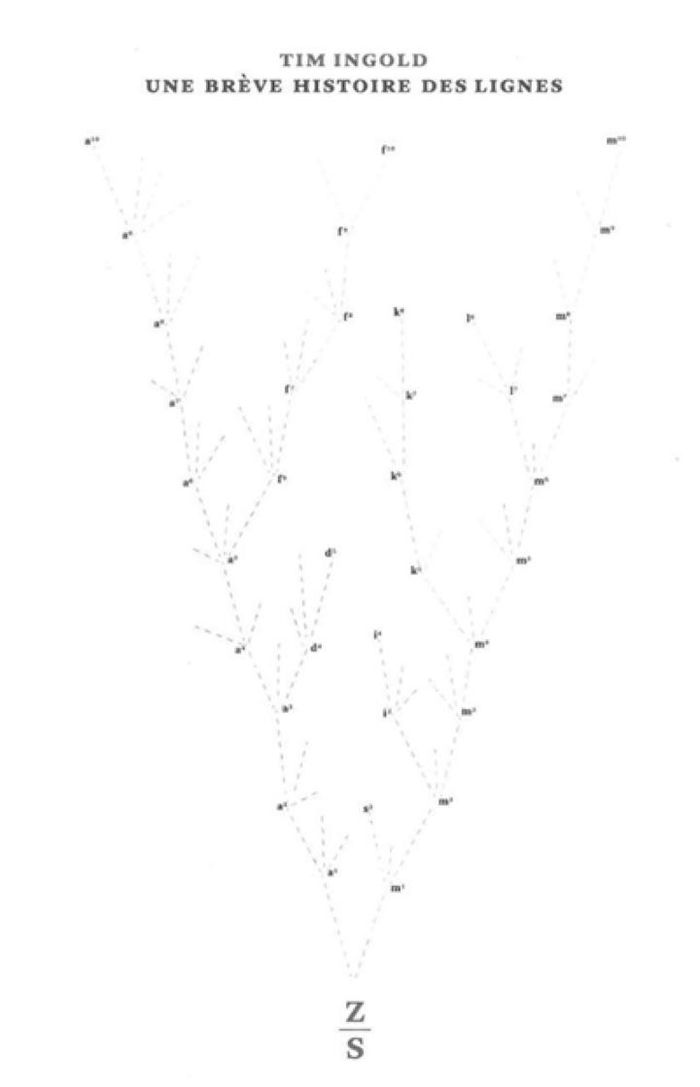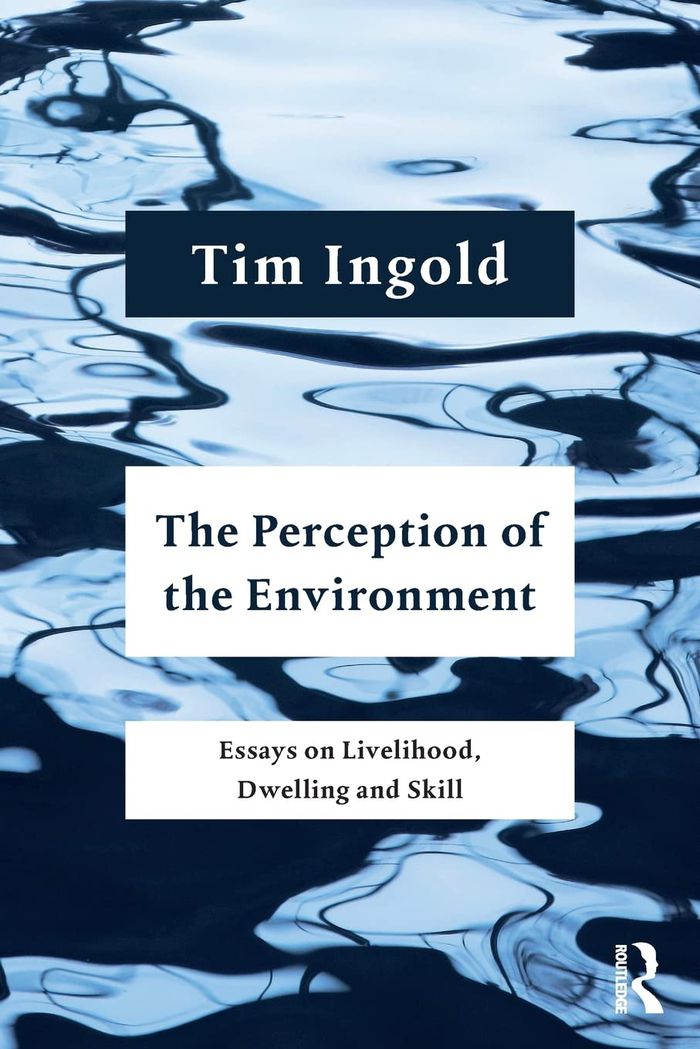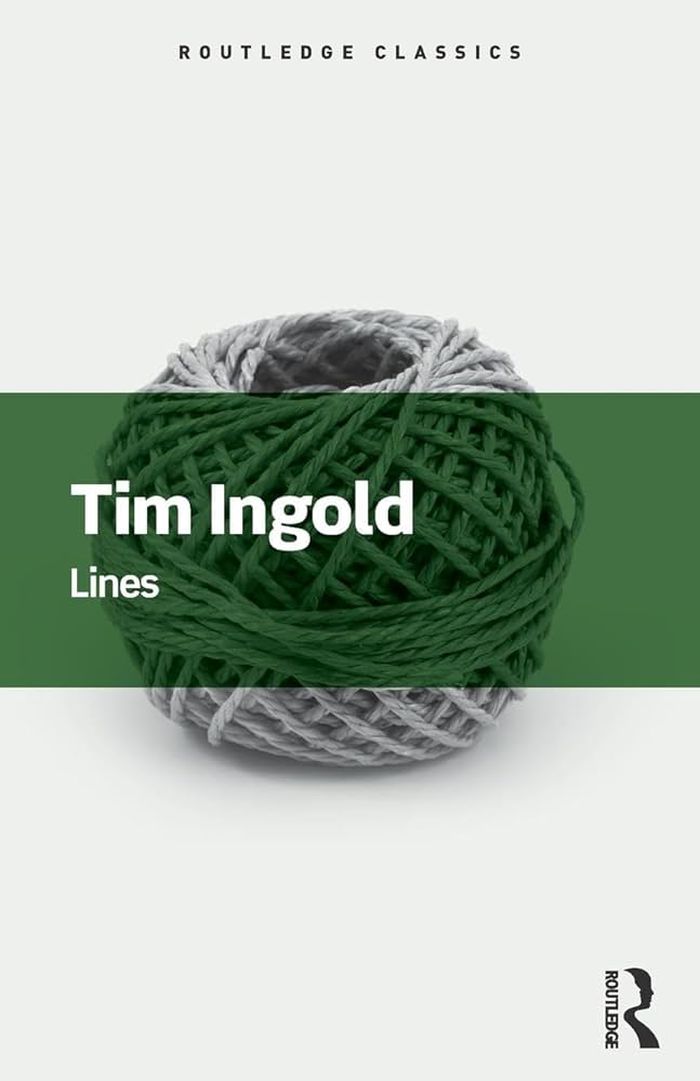$15.00
(available in store)
Summary:
L'éducation retournée par les arts : le célèbre anthropologue anglais Tim Ingold nous invite à considérer l'art, l'architecture et le design arts comme la base même d'une éducation pour le XXIe siècle en prise aux enjeux sociaux et écologiques auxquels nous sommes confrontés.
Architecture educates! : Au contact de l'art
Actions:
Price:
$15.00
(available in store)
Summary:
L'éducation retournée par les arts : le célèbre anthropologue anglais Tim Ingold nous invite à considérer l'art, l'architecture et le design arts comme la base même d'une éducation pour le XXIe siècle en prise aux enjeux sociaux et écologiques auxquels nous sommes confrontés.
Architectural Theory
books
Lines: a brief history
$49.50
(available to order)
Summary:
This is the first book to explore the production and significance of lines. As walking, talking, gesticulating creatures, human beings generate lines wherever they go: here, Ingold lays the foundations for an anthropological archaeology of the line. He investigates: speech and song in the cultures of Papua New Guinea, the Navaho and Meso America; paths, trails and maps(...)
Lines: a brief history
Actions:
Price:
$49.50
(available to order)
Summary:
This is the first book to explore the production and significance of lines. As walking, talking, gesticulating creatures, human beings generate lines wherever they go: here, Ingold lays the foundations for an anthropological archaeology of the line. He investigates: speech and song in the cultures of Papua New Guinea, the Navaho and Meso America; paths, trails and maps drawing, writing and calligraphy; and the modern and postmodern world. Written by a leading expert in the field and including over seventy illustrations, this text offers a radically different approach to anthropological and archaeological studies, taking us on a journey which will change the way we look at the world and how we move within it, and archaeological studies.
books
July 2007, New York
Architectural Drawing
$41.95
(available to order)
Summary:
D'où proviennent les formes ? Dans ce livre l'anthropologue Tim Ingold propose de déconstruire le modèle philosophique hylémorphique qui, depuis Aristote, pense l'acte de fabrication comme l'imposition d'une forme, ou d'un projet, à la matière inerte. Ce renversement théorique n'est possible qu'à la faveur d'une approche matérialiste de la fabrication qui révèle la(...)
Faire: anthropologie, archéologie, art et architecture
Actions:
Price:
$41.95
(available to order)
Summary:
D'où proviennent les formes ? Dans ce livre l'anthropologue Tim Ingold propose de déconstruire le modèle philosophique hylémorphique qui, depuis Aristote, pense l'acte de fabrication comme l'imposition d'une forme, ou d'un projet, à la matière inerte. Ce renversement théorique n'est possible qu'à la faveur d'une approche matérialiste de la fabrication qui révèle la correspondance des pratiques avec les matériaux, leur itinérance au sein de la matière pour engendrer des formes. Cette réflexion conduit Ingold à faire la proposition d'une pédagogie participante suggérant une nouvelle conception de l'enseignement fondée sur l'élucidation des pratiques constitutives des gestes de fabrication. L'anthropologie, l'archéologie, l'art et l'architecture ne sont pas ici considérées comme des disciplines académiques, mais comme des manières de faire qui explorent chacune, à leur façon, les conditions et les potentiels de la vie humaine au sein de son environnement.
Architectural Theory
Correspondences
$23.95
(available to order)
Summary:
We inhabit a world of more than humans. For life to flourish, we must listen to the calls this world makes on us, and respond with care, sensitivity and judgement. That is what it means to correspond, to join our lives with those of the beings, matters and elements with whom, and with which, we dwell upon the earth. In this book, anthropologist Tim Ingold corresponds(...)
Correspondences
Actions:
Price:
$23.95
(available to order)
Summary:
We inhabit a world of more than humans. For life to flourish, we must listen to the calls this world makes on us, and respond with care, sensitivity and judgement. That is what it means to correspond, to join our lives with those of the beings, matters and elements with whom, and with which, we dwell upon the earth. In this book, anthropologist Tim Ingold corresponds with landscapes and forests, oceans and skies, monuments and artworks. To each he brings the same spontaneity of thought and observation, the same intimacy and lightness of touch, but also the same affection, longing and care that, in the days when we used to write letters by hand, we would bring to our correspondences with one another. The result is a profound yet accessible inquiry into ways of attending to the world around us, into the relation between art and life, and into the craft of writing itself. At a time of environmental crisis, when words so often seem to fail us, Ingold points to how the practice of correspondence can help restore our kinship with a stricken earth.
Landscape Theory
$41.95
(available to order)
Summary:
Où qu'ils aillent et quoi qu'ils fassent, les hommes tracent des lignes : marcher, écrire, dessiner ou tisser sont des activités où les lignes sont omniprésentes, au même titre que l'usage de la voix, des mains ou des pieds. Dans « Une brève histoire des lignes », l'anthropologue anglais Tim Ingold pose les fondements de ce que pourrait être une « anthropologie comparée(...)
Une brève histoire des lignes
Actions:
Price:
$41.95
(available to order)
Summary:
Où qu'ils aillent et quoi qu'ils fassent, les hommes tracent des lignes : marcher, écrire, dessiner ou tisser sont des activités où les lignes sont omniprésentes, au même titre que l'usage de la voix, des mains ou des pieds. Dans « Une brève histoire des lignes », l'anthropologue anglais Tim Ingold pose les fondements de ce que pourrait être une « anthropologie comparée de la ligne » - et, au-delà, une véritable anthropologie du graphisme. Etayé par de nombreux cas de figure (des pistes chantées des Aborigènes australiens aux routes romaines, de la calligraphie chinoise à l'alphabet imprimé, des tissus amérindiens à l'architecture contemporaine), l'ouvrage analyse la production et l'existence des lignes dans l'activité humaine quotidienne. Tim Ingold divise ces lignes en deux genres - les traces et les fils - avant de montrer que l'un et l'autre peuvent fusionner ou se transformer en surfaces et en motifs. Selon lui, l'Occident a progressivement changé le cours de la ligne, celle-ci perdant peu à peu le lien qui l'unissait au geste et à sa trace pour tendre finalement vers l'idéal de la modernité : la ligne droite. Cet ouvrage s'adresse autant à ceux qui tracent des lignes en travaillant (typographes, architectes, musiciens, cartographes) qu'aux calligraphes et aux marcheurs - eux qui n'en finissent jamais de tracer des lignes car quel que soit l'endroit où l'on va, on peut toujours aller plus loin.
Social
$78.50
(available in store)
Summary:
In this work Tim Ingold offers a persuasive new approach to understanding how human beings perceive their surroundings. He argues that what we are used to calling cultural variation consists, in the first place, of variations in skill. Neither innate nor acquired, skills are grown, incorporated into the human organism through practice and training in an environment. They(...)
The perception of the environment: essays on livelihood, dwelling and skill
Actions:
Price:
$78.50
(available in store)
Summary:
In this work Tim Ingold offers a persuasive new approach to understanding how human beings perceive their surroundings. He argues that what we are used to calling cultural variation consists, in the first place, of variations in skill. Neither innate nor acquired, skills are grown, incorporated into the human organism through practice and training in an environment. They are thus as much biological as cultural. To account for the generation of skills we have therefore to understand the dynamics of development. And this in turn calls for an ecological approach that situates practitioners in the context of an active engagement with the constituents of their surroundings. The book is set to revolutionise the way we think about what is ‘biological’ and ‘cultural’ in humans, about evolution and history, and indeed about what it means for human beings – at once organisms and persons – to inhabit an environment.
Environment and environmental theory
Lines: a brief history
$45.95
(available in store)
Summary:
What do walking, weaving, observing, storytelling, singing, drawing and writing have in common? The answer is that they all proceed along lines. In this book, Tim Ingold imagines a world in which everyone and everything consists of interwoven or interconnected lines and lays the foundations for a completely new discipline: the anthropological archaeology of the(...)
Lines: a brief history
Actions:
Price:
$45.95
(available in store)
Summary:
What do walking, weaving, observing, storytelling, singing, drawing and writing have in common? The answer is that they all proceed along lines. In this book, Tim Ingold imagines a world in which everyone and everything consists of interwoven or interconnected lines and lays the foundations for a completely new discipline: the anthropological archaeology of the line. Ingold’s argument leads us through the music of Ancient Greece and contemporary Japan, Siberian labyrinths and Roman roads, Chinese calligraphy and the printed alphabet, weaving a path between antiquity and the present. Drawing on a multitude of disciplines including archaeology, classical studies, art history, linguistics, psychology, musicology, philosophy and many others, and including more than seventy illustrations, this book takes us on an exhilarating intellectual journey that will change the way we look at the world and how we go about in it.
Critical Theory
